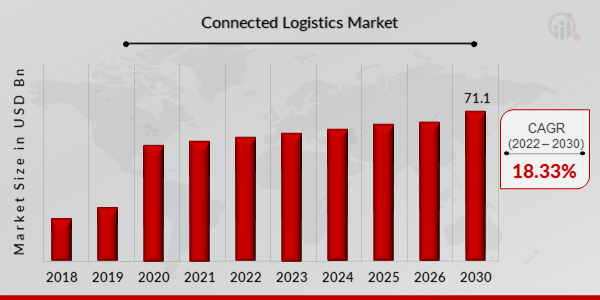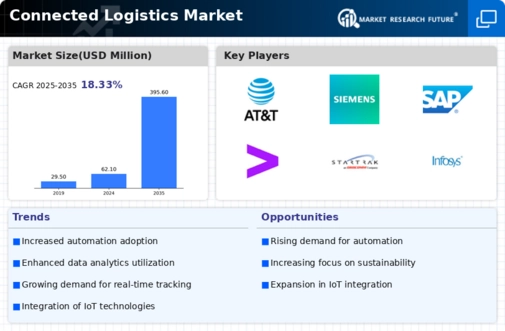E-commerce Growth
The surge in e-commerce activities is a crucial driver of the Global Connected Logistics Market Industry. As online shopping continues to expand, logistics providers are compelled to adapt their operations to meet the increasing demand for fast and reliable delivery services. This shift necessitates the implementation of connected logistics solutions to manage complex supply chains effectively. The market is anticipated to witness a compound annual growth rate of 18.33% from 2025 to 2035, underscoring the impact of e-commerce on logistics strategies and the need for innovative solutions.
Market Growth Projections
The Global Connected Logistics Market Industry is poised for substantial growth, with projections indicating a market value of 62.1 USD Million in 2024 and an anticipated increase to 395.6 USD Million by 2035. This growth trajectory suggests a compound annual growth rate of 18.33% from 2025 to 2035. Such figures reflect the increasing adoption of connected technologies in logistics, driven by factors such as e-commerce expansion, technological advancements, and heightened demand for transparency and sustainability.
Technological Advancements
The Global Connected Logistics Market Industry is propelled by rapid technological advancements, particularly in IoT and AI. These technologies enhance real-time tracking and data analytics, allowing companies to optimize their supply chains. For instance, IoT devices can monitor cargo conditions, leading to improved inventory management and reduced waste. As organizations increasingly adopt these technologies, the market is projected to reach 62.1 USD Million in 2024, reflecting a growing reliance on connected solutions to streamline operations and enhance efficiency.
Increased Focus on Sustainability
Sustainability has become a focal point in the Global Connected Logistics Market Industry, driven by both consumer preferences and regulatory pressures. Companies are increasingly adopting connected logistics solutions to minimize their environmental impact. This includes optimizing routes to reduce fuel consumption and utilizing data analytics to enhance resource efficiency. As organizations strive to meet sustainability goals, the demand for connected logistics solutions is expected to rise. This trend aligns with the broader movement towards greener practices in logistics, potentially leading to significant market growth in the coming years.
Government Initiatives and Regulations
Government initiatives aimed at enhancing logistics efficiency play a pivotal role in the Global Connected Logistics Market Industry. Various countries are implementing regulations that promote the adoption of smart logistics technologies. These initiatives often focus on sustainability, safety, and efficiency, encouraging businesses to invest in connected solutions. For example, regulatory frameworks that support the use of autonomous vehicles and drones in logistics are emerging. Such policies are likely to stimulate market growth, as they create an environment conducive to innovation and investment in connected logistics.
Rising Demand for Supply Chain Transparency
In the Global Connected Logistics Market Industry, there is a notable increase in demand for supply chain transparency. Stakeholders, including consumers and businesses, are increasingly seeking visibility into the logistics process. This trend is driven by the need for accountability and sustainability in operations. Companies that provide real-time updates and tracking capabilities are likely to gain a competitive edge. As a result, the market is expected to grow significantly, with projections indicating a value of 395.6 USD Million by 2035, highlighting the importance of transparency in modern logistics.

















Leave a Comment